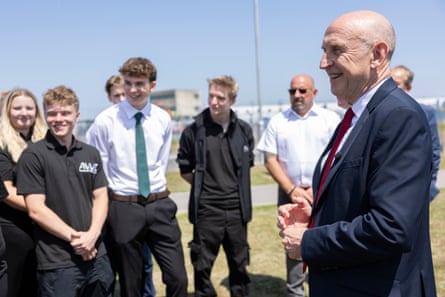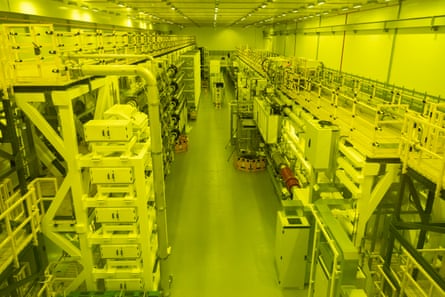Nestled in the heart of rural Berkshire, the 300-hectare (750-acre) military complex at Aldermaston is an incongruous sight. It comprises a mix of 1950s and 1960s institutional buildings, heated by a steam tube system more familiar in Soviet structures, and a handful of modern offices, several of which are in the process of being built.
But the technology inside the complex, one of Britain’s most sensitive defence locations, is far from that era of cold-war hostility. The sprawling campus is the largest of three locations where Britain manufactures its nuclear warheads – and where the UK will design and build a £15bn replacement for its current arsenal without making a single explosive test.
Armed police with carbine rifles patrol and watch from the rooftops, protecting the nuclear materials and the site’s 7,500 employees. The staff work for AWE, the former Atomic Weapons Establishment, whose project is at the heart of Labour plans to revitalise nuclear with weaponry that may last to the 2070s.
On Thursday, John Healey became the first defence secretary to visit the site since 2018, arguing that Labour was making a generational decision to support expensive weapons that he and other members of the government hoped would protect the UK by never coming close to being used.
“We’ve got a government recognising that we need to invest now if we’re going to be able to maintain our strength of our independent UK nuclear deterrence in the decades to come,” Healey said, wondering aloud why some of his immediate Conservative predecessors had not come to visit.

Labour’s previous leader, Jeremy Corbyn, was opposed to nuclear weapons, but under Keir Starmer the party firmly shifted to the pro-nuclear camp long before winning the election. It is now pressing forward with civil nuclear development, giving the go-ahead this month for a new £14.2bn reactor at Sizewell, in Suffolk, as well as the next nuclear bomb.
Ministers’ commitment to nuclear is one they believe has public backing. At a time of global uncertainty, not least with Israel attacking Iran to prevent the latter acquiring its own nuclear bomb, public support for the UK to maintain its stock of nuclear weapons is growing, they say.
Polling conducted by YouGov on behalf of the Ministry of Defence suggests support for Trident, the submarine-based nuclear weapons system, rose to 65% in March 2025, the highest level since sampling for the department began in 2018.
Components for Britain’s nuclear warhead – known as Holbrook – are designed, tested and built at Aldermaston. The warheads themselves are largely assembled at the nearby Burghfield site, before being transported by road to Coulport, in Scotland. The assembly process is completed there and the Trident missiles, with their British warheads, are loaded on to submarines at nearby Faslane.
Operations have begun to scale up at Aldermaston with the initial phases of work on the new warhead under way. About 1,500 employees have joined AWE in the past year, bringing the total number of workers at the state-owned company to 9,500. These are the kind of skilled jobs Labour is eager to talk up.
The new device, called Astraea, will not be ready for deployment until the 2030s or 2040s. Its explosive power is not yet known, though independent experts think it will probably be more than the 80-100kt Holbrook, and possibly closer to 475kt, a benchmark set by the most powerful US warhead.
For comparison, the bomb dropped on Hiroshima, which killed between 70,000 and 140,000 people (estimates vary widely), was 15kt.
after newsletter promotion
It will be designed at Aldermaston, principally using small test explosions which are then extrapolated by an onsite supercomputer, Damson, to simulate a nuclear blast. One engineer said Damson used 17MW of power, considerably more than the Met Office’s supercomputer, which consumes 2.7MW, and AWE says it can perform 4.3 million billion calculations per second.

The other key facility on the site is Orion, a set of 12 lasers that, when brought together, can simulate the moment a nuclear bomb is detonated. One scientist said the energy involved was “no greater than boiling a teaspoon of water” and there was “no danger of blowing up Reading”. In any event, the lasers come together in a vacuum to safeguard against any possible explosions.
Materials intended for the warhead are tested in the laser to see how they will behave when the bomb is blown, though the amounts involved are minute, often a few millimetres in size. To see if they can prepare the experiments, staff members are asked to build a tiny model of a bicycle, with handlebars and spokes. It is not a task for everybody; after six months some employees can manage but others cannot.
The question, though, is why a £15bn investment in a new nuclear warhead is necessary, because Holbrook warheads, if regularly refurbished, could continue to be viable. One reason for the upgrade is that the US is designing a new warhead, the W93. The UK and US programmes have operated in parallel, sharing design features to save money, but not fissile materials (plutonium or enriched uranium), which would breach the nuclear non-proliferation treaty to which both countries are signatories.
A second reason, said David Cullen, a nuclear expert at the Basic thinktank, was for “the UK to maintain its position as a member of the nuclear club”. The issue is partly one of skills: “The capability to deploy warheads atrophies if you don’t have warhead designers who have actually made a nuclear bomb,” he added. But that is the cost, in other words, of the UK maintaining a seat near the top of the diplomatic table.

 2 months ago
31
2 months ago
31

















































